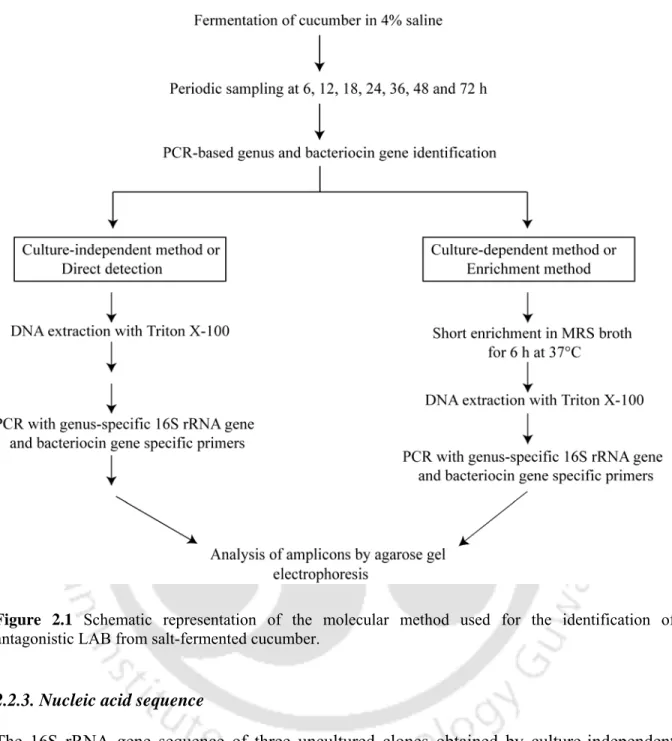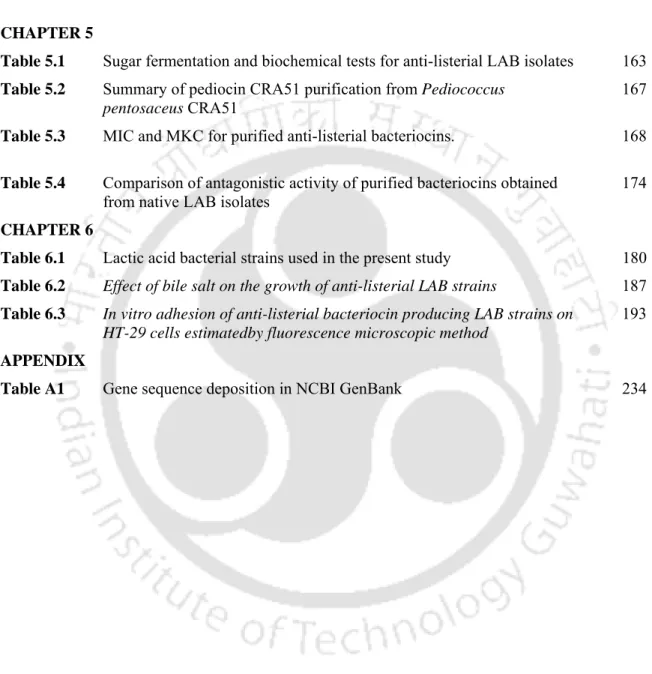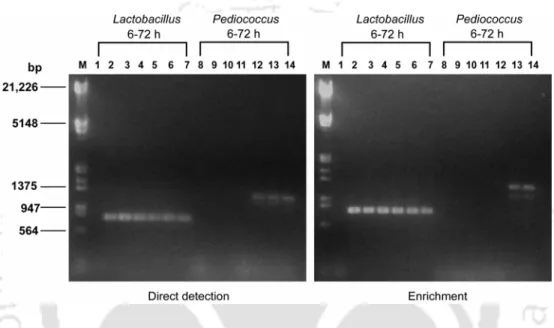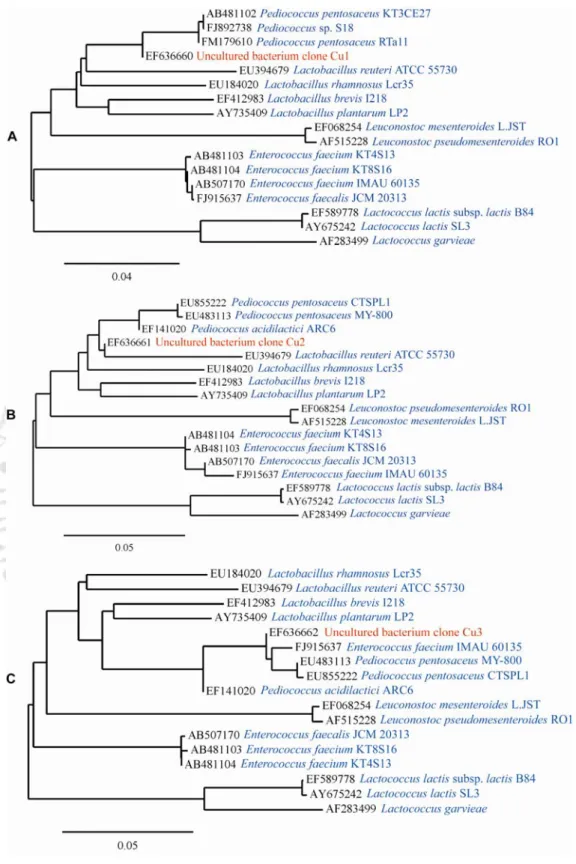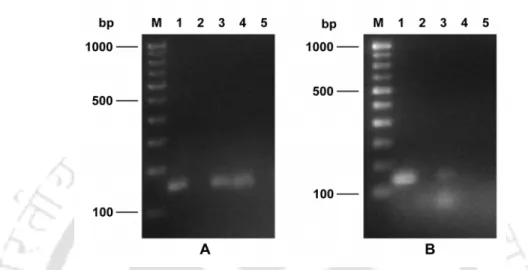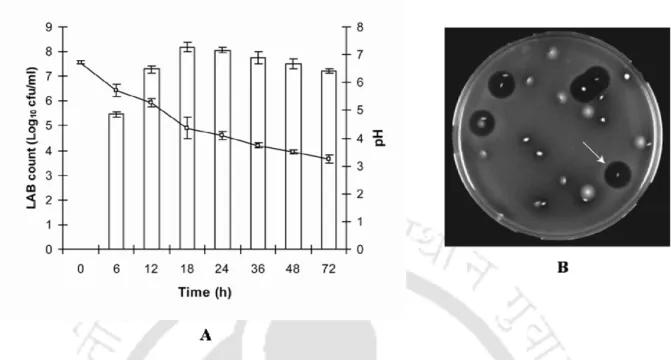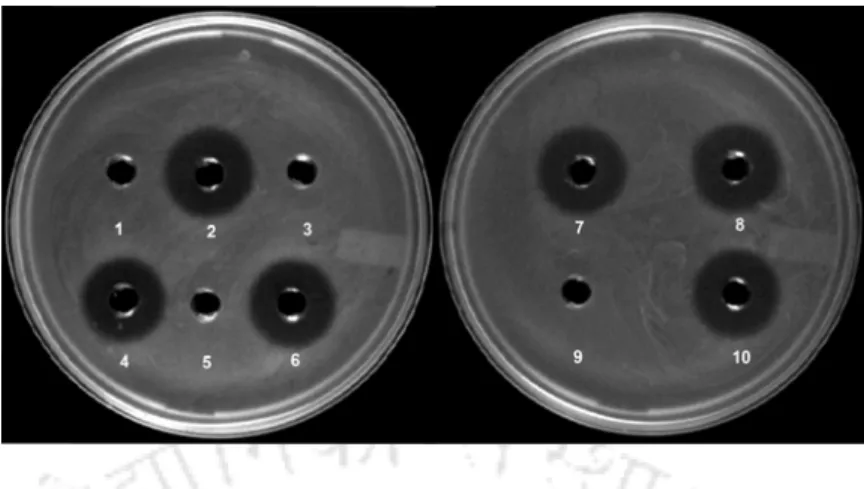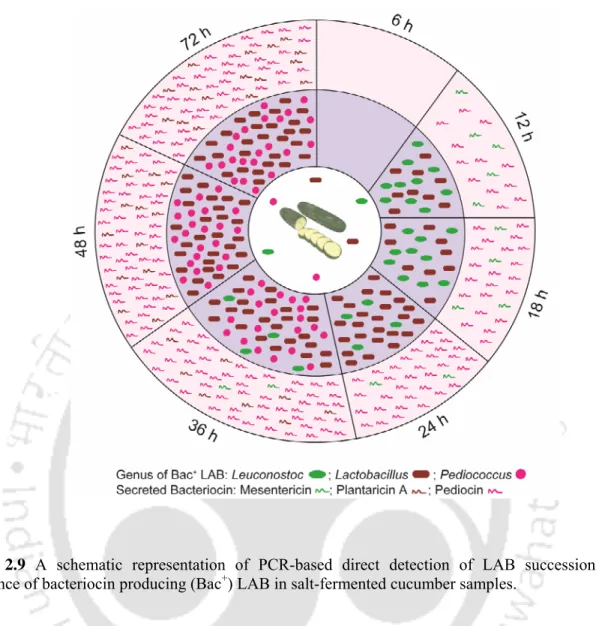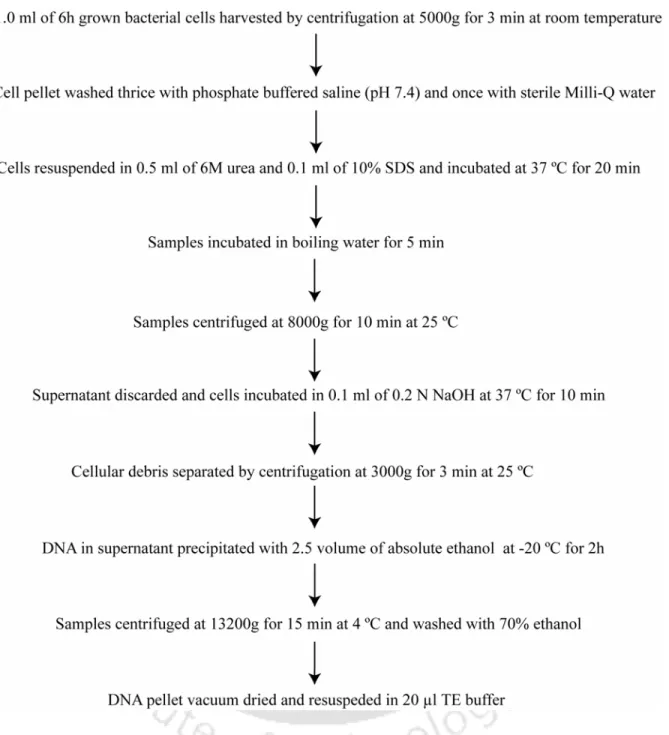I hereby declare that the research findings of this dissertation are the result of the research work done by me at the Department of Biotechnology, Indian Institute of Technology, Guwahati, Guwahati, India under the supervision of Dr. Atul Kumar Singh for the award of the degree of Doctor of Philosophy is an authentic record of the results obtained from the research work carried out under my supervision in the Department of Biotechnology, Indian Institute of Technology, Guwahati, India, and this work has not been submitted elsewhere for the award of the degree in any form. Aiyagari Ramesh for his constant encouragement, guidance and support throughout my research work and; it enabled me to understand the subject and develop the skills to carry out research work.
Scope and significance of the present research work 27 Specific objectives of the present research work 30 CHAPTER 2: Molecular detection of bacteriocin-producing lactic acid bacteria during succession in salt-fermented cucumbers. CHAPTER 4a: Isolation, molecular detection and characterization of bacteriocin-producing lactic acid bacteria against Listeria from a domestic source. CHAPTER 4b: Assessment of genetic diversity of bacteriocin-producing lactic acid bacteria against Listeria using an arbitrary primary PCR-based fingerprinting method.
Comparative studies on the functional characterization of potent anti-listerial bacteriocin produced by lactic acid bacteria
Selection of LAB specific 16S rRNA primer for arbitrarily primed PCR (AP-PCR) and in silico melting point analysis.
Quantitative assessment of the in vitro adhesion potential of potent anti-listerial bacteriocin producing lactic acid bacteria
L IST OF FIGURES
Clusters were generated based on the Dice coefficient values of the sample of bands obtained in rep-PCR with a primer based on BOXA1R elements. CRA52 on the growth of Listeria monocytogenes Scott A inoculated into commercial samples of paneer and stored at 8 °C for 5 days. Clusters were created based on the Dice coefficient values of the sample of bands obtained in AP-PCR with primer ARAK5.
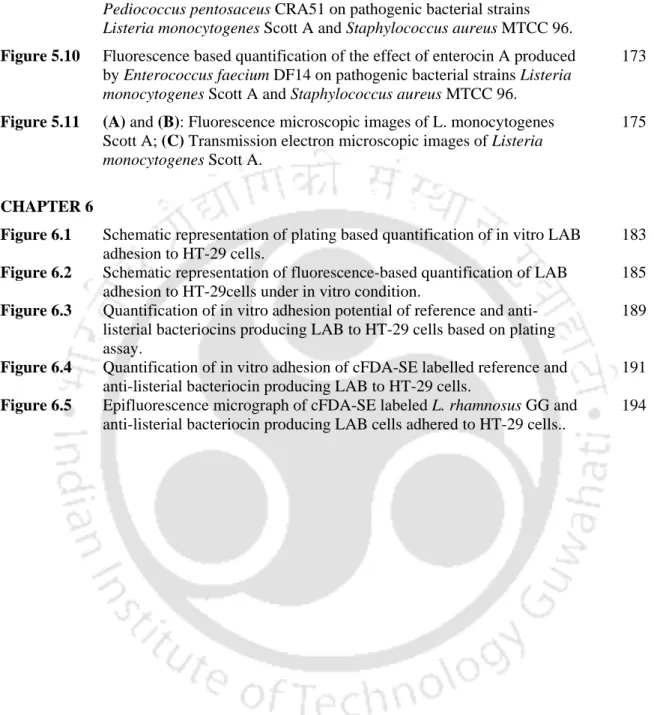
L IST OF TABLES
A BBREVIATIONS
Lactic acid bacteria (LAB)
Lactic acid bacteria (LAB) belong to the microaerophilic, non-sporulating, catalase-negative, non-motile and gram-positive group of bacteria that have a low G+C content and mainly produce lactic acid as a metabolic product (Vandamme et al. , 1996 ). Of the bacteriocins produced by LAB, nisin, produced by Lactococcus lactis, has been approved by the US Food and Drug Administration (FDA) for use in food as a supplement to functional foods (Cotter et al., 2005; de Arauz et al., 2009) . Lactic acid bacteria (LAB) have the ability to pursue their metabolically active physiological state in different ecological niches (Konings et al., 2000).
LAB possess ATP-binding cassette (ABC) transporter proteins and the sugar phosphotransferase system (PTS), which provides the capacity to use nutrients and survive in different ecological zones (Davidson et al., 2008). LAB produce free amino acids through proteolysis and convert them to aroma-forming compounds through amino acid catabolism (Gobbetti et al., 2005). The α-keto acids are then further converted to aldehydes, alcohols and esters as aromatic compounds (Liu et al., 2008).
LAB classification
Phenotypic and biochemical method of LAB classification
Some of the salient tests that aid genus-level identification of LAB are indicated in Table 1.1. The morphology of a bacterium includes both cellular (shape, endospore, flagella, inclusion bodies and gram stain) and colony (color, dimensions, shapes) characteristics. 1996) and Stiles and Holzapfel (1997) reported in their review that physiological and biochemical characteristics data on growth at different temperatures, pH values, salt concentrations, atmospheric conditions, growth in the presence of various substances such as antimicrobial agents and data on the presence or activity of various enzymes and metabolic products. The phenotypic method of bacterial classification also includes analysis of cell wall composition (Schleifer et al., 1972), cellular fatty acid, whole cell protein profile (Descheemaeker et al., 1994) and electrophoretic mobility of lactate dehydrogenase protein.
Phenotypic methods of LAB classification are simple and do not require modern equipment for experiments. However, the procedures are difficult and often provide poor distinction between the LAB genus since most of the LAB share common metabolic process and the enzymes involved in metabolism. The insufficient discriminatory potential of phenotypic methods necessitates the application of molecular methods in the classification and taxonomy of lactic acid bacteria.
Molecular methods for LAB classification and identification
The number of rRNA (rrn) operons located on a genome varies considerably between species and is correlated with the speed at which microbes can respond to available resources. In lactic acid bacteria, complete genome sequences of Lactobacillus plantarum, Lactococcus lactis and Lactobacillus johnsonii were used to compare the location, sequence, organization and regulation of the ribosomal RNA (rrn) operons (de Vries et al., 2006). With automated sequencing systems and the availability of PCR-based direct sequencing tools, the 16S rRNA sequence has become an extremely important tool for reliable identification and classification of LAB strains.
Previous studies have reported the application of 16S rRNA primers to detect a specific LAB genus or species using conventional and multiplex PCR approaches (Chagnaud et al., 2001; Dubernet et al., 2002; Settanni et al., 2005). Research efforts are also focused on the design of 16S rRNA primers and their application to monitor LAB dynamics and community development in the food system (Delbe's et al., 2007; Randazzo et al., 2006). The rRNA heterogeneity among LAB species has also been judiciously exploited in PCR-DGGE (denaturing gradient gel electrophoresis), resulting in powerful analysis of the LAB population in a variety of food matrices (Cocolin et al., 2006; Cocolin et al., 2007 ; Randazzo et al., 2009).
Molecular fingerprinting methods to study LAB strain variations and phylogeny Genotypic techniques based on fingerprinting analysis exhibit various levels of
RAPD has been shown to be useful in distinguishing strains belonging to Lactobacillus acidophilus (Du Plessis et al., 1995; Gancheva et al., 1999). Several other studies by different research groups report the use of RAPD for LAB strain identification (Bouton et al., 2000; Rossetti and Giraffa, 2005; Pulido et al., 2005; Ruiz et al., 2008). Many reports indicate the use of rep-PCR methods for molecular typing and characterization of LAB strains (De Angelis et al., 2007; Gevers et al., 2001; Nikolic et al., 2008; Terzic-Vidojevic et al., 2007).
Most of the molecular techniques discussed in the aforementioned section do not provide genome-wide information. Pulsed-field electrophoresis (PFGE) is one of the most powerful techniques for obtaining genome-wide information. The use of PFGE for molecular genotyping of LAB strains has been documented (Bouton et al., 2002; Ventura and Zink, 2002).
Role of LAB in food fermentation
Food fermentation processes controlled by defined strains of LAB have attracted great attention from consumers for minimally processed food products with definite aroma, flavor and sensory properties. LAB play an important role in food fermentation processes to increase the shelf life and organoleptic value of fermented food products (Topisirovic et al., 2008). Moreover, various physiological and technological properties of LAB confer desirable characteristics to the fermented products such as unique aroma, flavor and texture as (Coolbear et al., 2008; . Leroy and De Vuyst, 2004).
Among the antimicrobial metabolites, bacteriocins have attracted great attention for their application in food and feed systems as antimicrobial agents under the regime of natural biopreservatives (Cotter et al., 2005; Drider et al., 2006; O'Sullivan et al., 2002). . Such fermentation process leads to the succession of LAB based on their antagonistic and adaptability properties (Haruta et al., 2006; Kostinek et al., 2007). Microbial succession of LAB with the emergence of dominant and antagonistic strains also depends on the functional properties of LAB species such as the ability to synthesize and secrete bacteriocin, resistance to harsh fermentation environment (pH, competition and antagonistic metabolites) and the ability to utilize available nutrients in the environment (De Vuyst and Vancanneyt, 2007).
Bacteriocins produced by LAB
Thus, bacteriocins can then reduce the use of antibiotics and thus the risk of developing antibiotic resistance. In addition, consumer awareness of health risks associated with the use of chemical preservatives in food has increased interest in bacteriocins.
Bacteriocin classification
Class I
It is also noteworthy that bacteriocins are naturally produced, are usually proteinaceous and therefore can be degraded under physiological conditions of the intestinal environment. This class of bacteriocin molecules are generally small (<10 kDa), heat-stable, non-lanthionine-containing membrane-active peptides.
Class III
- Operon structure, synthesis and secretion
- Operon structure of a typical Class IIa bacteriocin produced by LAB
- Structure-function relationship and antimicrobial spectrum of Class IIa bacteriocin
- Mode of action of Class IIa bacteriocin
- Methods to detect bacteriocin activity
- Culture-dependent approach
- Culture-independent approach
- Probiotic attributes of LAB and their adhesion potential
- Materials and Methods
- Judicious design of genus-specific and bacteriocin gene specific primers in conjunction with a simple DNA extraction method enabled PCR-based detection of all four major LAB
- Time-dependent succession of LAB genera in the fermenting samples was monitored and the succession of the LAB population could be rationally linked to the emergence of
- Quantitative differences could be observed in the culture-independent and culture- dependent methods thus accounting for the biased selection usually associated with
- Materials and Methods
- Results and Discussion 1. Isolation of template DNA
- Conclusion
- The reliability of the DNA extraction method was validated as templates prepared from LAB strains by urea-SDS-NaOH method and a commercially available kit yielded
- A major highlight of the investigation was the successful implementation of the template DNA extraction method in facilitating PCR-based direct detection of LAB in fermented
- Another important application of the template DNA extraction method was emphasized when PCR-compatible DNA was extracted from bacteriocin producing native LAB strains
- The DNA extraction method outlined in the present investigation can be adopted on a routine basis in food microbiology laboratories for PCR-based detection of LAB in various
- Interestingly, many of the isolates exhibited a broad spectrum antimicrobial activity against foodborne bacterial pathogens and in some cases antagonism towards certain Gram-negative
- Partial characterization of the antimicrobial compound emphasized the presence of bacteriocin
- The mode of action of the bacteriocin produced by some of these isolates was demonstrated by a sensitive fluorescent dye-leakage assay
- A significant outcome of the present investigation was to demonstrate the promise of plantaricin A, an anti-listerial bacteriocin produced by strain Lactobacillus plantarum CRA52
- In the present study a primer targeting a region of the 16S rRNA gene which is unique and conserved amongst a large number of LAB strains was selected. Application of the primer in
- The taxonomic value of the primer was further substantiated as defined and stable fingerprinting patterns could be obtained from a number of standard strains of Lactobacillus
- A significant application of the primer was realized when two standard LAB strains used as starter cultures for the preparation of the fermented milk product dahi could be
- Finally, a salient achievement of the study was the application of the primer in AP-PCR based fingerprinting of select anti-listerial bacteriocin producing LAB strains and
- Introduction
- Materials and Methods
- Results and Discussion
In the current thesis, the main focus is on the isolation of Class IIa bacteriocin-producing LAB and characterization of the bacteriocin molecule. Estimation of the genetic diversity of anti-listerial bacteriocin-producing LAB strains using a novel AP-PCR-based fingerprinting method. The majority of bacteriocins detected in the natural isolates (mesentericin, pediocin and plantaricin A) belong to the class IIa category, which is known to act on closely related LAB strains (Ennahar et al., 2000).
Therefore, the next objective was to determine the genetic diversity of the antagonistic bacteriocin-producing LAB isolates obtained from fermented cucumber samples. In this study, a short pretreatment of the fermented samples with PBS-T (PBS and Tween-20) was included. Characterization and comparative analysis of the potency of bacteriocin produced by selected LAB isolates is reported.
Some LAB isolates from dried fish samples exhibit significant antilisterial activity. The representative amplicons of the bacteriocin gene obtained from selected LAB isolates are shown in Figure 4a.3. The designed primer for AP-PCR based method clearly revealed the genetic diversity of the anti-listerial LAB isolates.
The method essentially uses a primer that targets a highly conserved region of the 16S rRNA gene of LAB strains. AP-PCR based fingerprinting analysis of anti-listerial LAB isolates was performed with ARAK5 primer. In the present study, a primer specific for a conserved region of the 16S rRNA gene of LAB strains was selected and used for fingerprint analysis of anti-listerial bacteriocin-producing LAB isolates.
In the present study, a primer targeting a region of the 16S rRNA gene, which is unique and conserved among a large number of LAB strains, was selected. Primer application in AP-PCR based fingerprinting analysis resulted in significant discrimination of LAB and non-LAB strains. In the next chapter of the thesis, the species-level identification of three potent anti-listerial isolates producing bacteriocin LAB CRA21, CRA51 and DF14 is described.
Purification of the bacteriocin produced by potent anti-listerial LAB isolates (6 nos.) was accomplished by the cell adsorption method described by Halami et al. Figure 5.5 shows a schematic representation of the main steps involved in the purification of the bacteriocin molecule .
